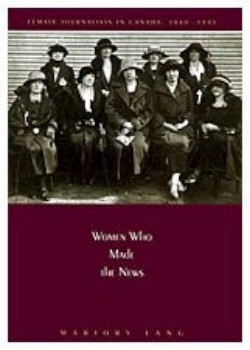Women Who Made the News
Female Journalists in Canada 1880-1945
When Marjorie Earl joined the general reporting staff of the Toronto Star in 1942, the publisher—believing the presence of a female in the city department would “demoralize the male reporters”—had her desk placed in with the other ladies working on that newspaper’s women’s section. A long telephone cord, however, connected Earl to the newsroom.
In this extensively-researched treatise, Lang traces the bumpy road Canadian women journalists traveled—from humble beginnings as contributors free-lancing from their homes while raising families to a time when they were recognized by newspapers as a valuable revenue source and actively sought out and employed to attract female readers.
Even then, only a couple of avenues were open to a woman who wanted to work in this field, such as covering society and clubs for the
constantly looked-down-upon and much-maligned women’s section. The negative view of this section of the newspaper, however, was one held mainly by male-dominated “insiders.” Lang shows that work done by women here was exemplary (though appropriate pay was another matter). It also provided a fertile jumping off point for additional career opportunities in other areas of journalism not yet open to the “fairer sex,” such as agriculture, finance and war correspondence.
Famous and not-so-famous personalities are recounted, such as Kate Aitken, a farm wife in the 1920s who started out making extra income by selling home produce (eggs, canned fruit, vegetables). Through a series of events and her own perseverance, this home-making expert and early radio personality in 1927 “managed to sell a large purchase of Canadian grain to Italy and when Mussolini vetoed the sale” flew to Rome and convinced the dictator to change his mind.
The Canadian Women’s Press Club, born during a trip to the 1904 World’s Fair in St. Louis, played a major role during the time period covered by Lang. The CWPC history is entwined throughout the book and it’s a source often cited by the author.
Lang, who teaches history at Langara College, Vancouver, British Columbia, presents a broad, historical perspective of a subject matter previously untouched. She wrote about Vancouver newspaper women in the early part of this century in a previous book.
Reviewed by
Robin Farrell Edmunds
Disclosure: This article is not an endorsement, but a review. The publisher of this book provided free copies of the book to have their book reviewed by a professional reviewer. No fee was paid by the publisher for this review. Foreword Reviews only recommends books that we love. Foreword Magazine, Inc. is disclosing this in accordance with the Federal Trade Commission’s 16 CFR, Part 255.

